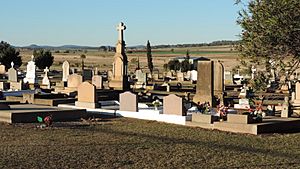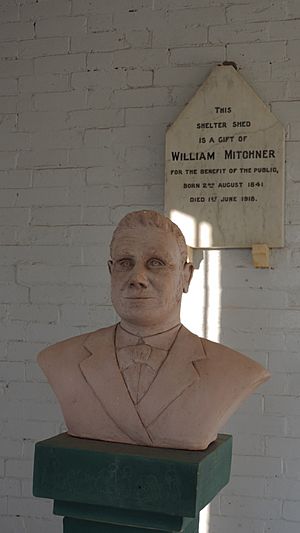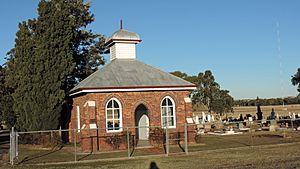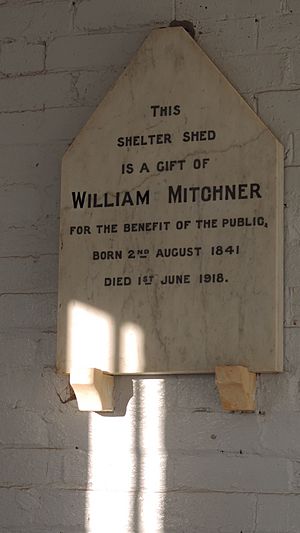Allora Cemetery facts for kids
Quick facts for kids Allora Cemetery |
|
|---|---|

Allora Cemetery, 2015
|
|
| Location | Allora-Clifton Road, Allora, Southern Downs Region, Queensland, Australia |
| Design period | 1840s - 1860s (mid-19th century) |
| Built | 1864 |
| Official name: Allora Cemetery | |
| Type | state heritage (built) |
| Designated | 27 April 2001 |
| Reference no. | 602153 |
| Significant period | 1864-ongoing (fabric, historical use) |
| Significant components | tower - bell / belfry, grave surrounds/railings, toilet block/earth closet/water closet, headstone, columbarium, plaque, shed - tools, pathway/walkway, tree groups - avenue of, burial/grave, memorial/monument, memorial - pavilion, gate - entrance, grave marker, denominational divisions, road/roadway |
| Lua error in Module:Location_map at line 420: attempt to index field 'wikibase' (a nil value). | |
Allora Cemetery is a special place in Allora, Queensland, Australia. It is a heritage-listed cemetery on Allora-Clifton Road. The cemetery was first opened in 1864. It was added to the Queensland Heritage Register on 27 April 2001 because of its historical importance.
A Look Back in Time
Allora Cemetery is located north-west of Allora. It has always been set up with different sections for various religious groups. The cemetery holds many monuments and memorials. These remember people who lived in Allora and the surrounding area.
How Allora Began
In 1827, explorer Allan Cunningham discovered the Darling Downs. This area had great potential for farming. In the 1840s, farmers and shepherds settled here. They built huts near Allora Mountain. This spot was easy to cross Dalrymple Creek. It became a popular resting place for teamsters. These were people who drove wagons on the Warwick-Drayton Road. This was the start of Allora Township. The first inn was built in 1857. The town was officially planned in 1859. Land sales began in March 1860.
During the 1860s, Allora grew as a service center for local farms. The town soon had a police station and a post office. It also got a school, a cemetery, and a courthouse. In 1869, Allora became a municipality. This meant it had its own local government.
Early Burials and Management
The first person buried in Allora Cemetery was John Rhinehart in 1864. His wooden cross is no longer there. Dr. Sadjucis, a German doctor from the 1860s, also rests here. He had a heart attack while riding his horse. The oldest headstone you can still see is from 1867. It belongs to Charles Henry Bullock, a manager from Clifton Station. He was buried in the Church of England section.
An area of about 6.5 hectares was set aside for the cemetery in 1879. However, it was not officially recognized until 1893. The local councils of Allora and Clifton managed the cemetery. In 1915, the Allora Shire Council took over its control. Today, the Southern Downs Regional Council manages the cemetery.
The William Mitchner Shelter-shed
The most noticeable memorial in the cemetery is the William Mitchner Shelter-shed. It is a brick building near the front gate. This shelter was built between 1925 and 1926. It was designed as a place for people to gather during funerals. It also offered shelter from the weather.
William Mitchner was born in Germany in 1841. He came to Allora around 1872. He worked at a flour mill and later owned a shop. William became a successful investor. When he died in 1918, he left money for the shelter-shed. He wanted it to have a bell and a bust of himself. The bell was meant to ring when a funeral approached. He also left money for the shelter's upkeep.
There were some legal issues with William Mitchner's will. This was partly because Australia was at war with Germany. It took several years to sort out. Finally, the shelter-shed was put out for tender in 1925. The bust of William Mitchner was created by Charles Astley. The bell no longer rings today.
People Remembered Here
While families usually pay for memorials, sometimes the community does. Alexander Cameron was Allora's first Municipal Council clerk. After he died in 1882, his townsmen put up a small monument for him. Rev. James Boyd Morrow was an Allora Presbyterian Minister. His church members put up a tall monument for him after he died in 1893.
Many interesting people are buried here. Samuel Gordon was an early pioneer. He built Allora's second hotel in 1864. Travers Robert Goff was a bank manager. His daughter, Helen Lyndon, became famous as Pamela Lyndon Travers. She wrote the Mary Poppins books.
The cemetery also holds memorials for important local figures. These include pastoralist George John Edwin Clark. He was known for his high-quality merino wool. William Naish, an early pioneer, found the famous Talgai Skull in 1886. Edward Anderson was an early mayor of Allora. Henry Ludgate was a police officer who served as an alderman.
Many early settlers still have family in the area. James and Rhoda Gwynne arrived in 1862. Mrs. Gwynne opened the first school. They also opened the first Allora Post Office. William Deacon was Allora's first State School teacher. He later became a successful businessman and served on the local Council for 39 years.
In the past, many children did not live to be old. Like all cemeteries, Allora has graves for very young children. These often have small headstones. For example, Mary Ann Holmes died at 9 months old in 1867. Mabel Hancock died at 15 months old in 1887.
Some graves do not have headstones. This includes those of Queen Charlotte and Kitty Kitty. It is believed they were the last local Aboriginal people. They were buried in the southeastern part of the cemetery. The cemetery also contains two Commonwealth war graves. These are for Australian soldiers who died in World War II.
Allora Cemetery also has a columbarium for ashes. It also has a lawn cemetery section. Mark Brelsford was buried here in 1996. He was a plumber who collected local history. He wrote two books about the district.
What the Cemetery Looks Like
Allora Cemetery is surrounded by farms. It is about 3 kilometers north-west of Allora. The western side has a fence with pepperina trees. A creek runs along the southern side.
The cemetery has a grid of roads and paths. Signs show the different religious sections. A main driveway is lined with cypress trees. At the northern end, a road separates the lawn cemetery from the Methodist and Catholic sections. There is a brick columbarium near this entrance.
The Mitchner Shelter-shed
The Mitchner Shelter-shed is the largest memorial. It faces the road, next to the main entrance. A path leads to this building. It is about 5 meters square. The walls are made of solid brick. The roof is made of corrugated iron. It rises to a square timber steeple with a dome and a pointed top.
The main entrance faces west. It has a central arched opening. There are also arched windows on either side. The back wall has a gothic arched opening. The north and south walls have rectangular windows. The outside walls have pairs of corner buttresses.
Inside, a marble plaque on the back wall tells about William Mitchner. It says he gave the shelter as a gift for the public. It also gives his birth and death dates. The inside brickwork is painted. The floor is concrete with a special finish called terrazzo. The ceiling is made of fibro. There is a small toilet inside.
North of the shelter-shed, there is a small shelter for gravediggers. It has a corrugated iron roof supported by timber posts. It also includes a small shed that can be locked.
Memorials and Headstones
The inscriptions on the memorials show where early settlers came from. Many were from England, Scotland, and Ireland. Some were from Wales, Germany, and other European countries. There are monuments for pioneers, immigrants, and local people. These include ministers, bank managers, teachers, and farmers.
The gravestones vary a lot. Some are simple upright tablets. Others are more detailed, from the late Victorian period. You can see obelisks, Celtic and Calvary crosses. Some have urns on top of columns. Others are flat slabs with tablets. There are single graves and family plots. Some have cast-iron fences, while many have concrete borders. Some were made by local stonemasons.
The cemetery grounds are well kept. However, some monuments show signs of age. A few have even fallen over.
Why Allora Cemetery is Special
Allora Cemetery was listed on the Queensland Heritage Register in 2001. This means it is important to Queensland's history.
Showing History
The cemetery helps us understand Queensland's history. It shows us about the jobs, social standing, and people of the Warwick district. It also shows the different cultures, religions, and ethnic groups that lived in the town since the 1860s.
A Good Example of a Cemetery
Allora Cemetery is a great example of its kind. It has many different headstones and monuments. These show how people's ideas about remembering the dead have changed over time. The memorials reflect the social, religious, and architectural history of Allora. They cover from the 1860s up to today.
Beautiful Design
The design of the shelter-shed is considered beautiful by the community. The different headstones are also valued for their appearance. The cemetery's layout, with its central avenue of evergreen trees and paths, is also seen as aesthetically pleasing.
Important to the Community
The brick Mitchner Shelter-shed was a gift from William Mitchner. It was meant to help the community. It provides a covered resting area during funerals. People can also use it when visiting graves or to get out of the weather. It is a special meeting place. This shelter-shed has a strong connection with the Allora community. It is important for social, cultural, and spiritual reasons.
Connected to Important People
The cemetery is connected to many important people and families. These individuals helped shape the history of Allora and the surrounding area. They are part of the stories of pioneering life in Queensland.




